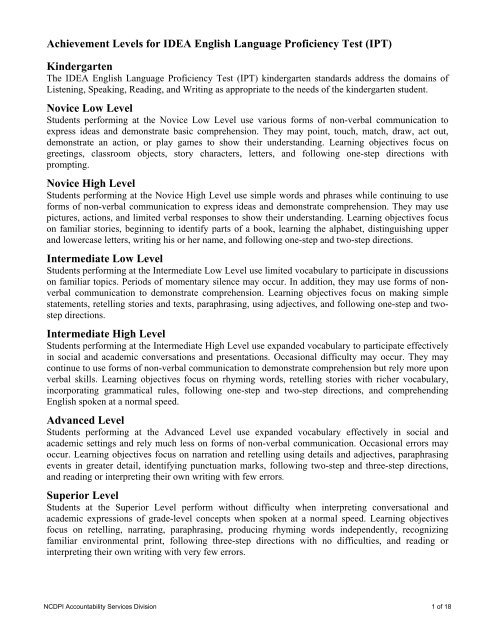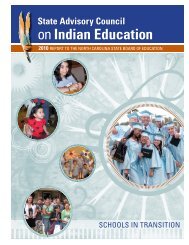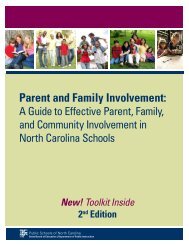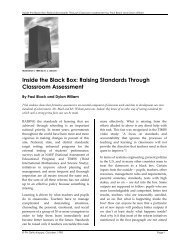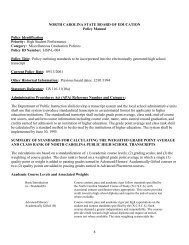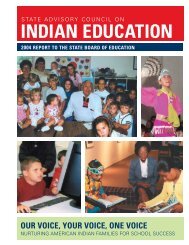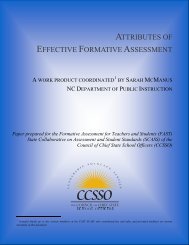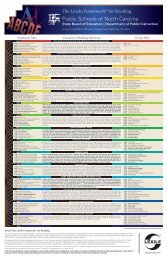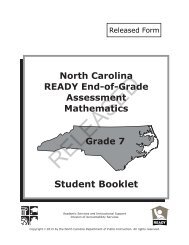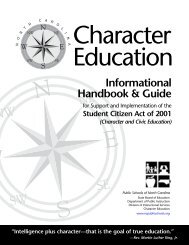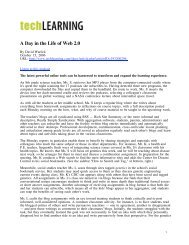Achievement Levels for IDEA English Language Proficiency Test (IPT)
Achievement Levels for IDEA English Language Proficiency Test (IPT)
Achievement Levels for IDEA English Language Proficiency Test (IPT)
You also want an ePaper? Increase the reach of your titles
YUMPU automatically turns print PDFs into web optimized ePapers that Google loves.
<strong>Achievement</strong> <strong>Levels</strong> <strong>for</strong> <strong>IDEA</strong> <strong>English</strong> <strong>Language</strong> <strong>Proficiency</strong> <strong>Test</strong> (<strong>IPT</strong>)<br />
Kindergarten<br />
The <strong>IDEA</strong> <strong>English</strong> <strong>Language</strong> <strong>Proficiency</strong> <strong>Test</strong> (<strong>IPT</strong>) kindergarten standards address the domains of<br />
Listening, Speaking, Reading, and Writing as appropriate to the needs of the kindergarten student.<br />
Novice Low Level<br />
Students per<strong>for</strong>ming at the Novice Low Level use various <strong>for</strong>ms of non-verbal communication to<br />
express ideas and demonstrate basic comprehension. They may point, touch, match, draw, act out,<br />
demonstrate an action, or play games to show their understanding. Learning objectives focus on<br />
greetings, classroom objects, story characters, letters, and following one-step directions with<br />
prompting.<br />
Novice High Level<br />
Students per<strong>for</strong>ming at the Novice High Level use simple words and phrases while continuing to use<br />
<strong>for</strong>ms of non-verbal communication to express ideas and demonstrate comprehension. They may use<br />
pictures, actions, and limited verbal responses to show their understanding. Learning objectives focus<br />
on familiar stories, beginning to identify parts of a book, learning the alphabet, distinguishing upper<br />
and lowercase letters, writing his or her name, and following one-step and two-step directions.<br />
Intermediate Low Level<br />
Students per<strong>for</strong>ming at the Intermediate Low Level use limited vocabulary to participate in discussions<br />
on familiar topics. Periods of momentary silence may occur. In addition, they may use <strong>for</strong>ms of nonverbal<br />
communication to demonstrate comprehension. Learning objectives focus on making simple<br />
statements, retelling stories and texts, paraphrasing, using adjectives, and following one-step and twostep<br />
directions.<br />
Intermediate High Level<br />
Students per<strong>for</strong>ming at the Intermediate High Level use expanded vocabulary to participate effectively<br />
in social and academic conversations and presentations. Occasional difficulty may occur. They may<br />
continue to use <strong>for</strong>ms of non-verbal communication to demonstrate comprehension but rely more upon<br />
verbal skills. Learning objectives focus on rhyming words, retelling stories with richer vocabulary,<br />
incorporating grammatical rules, following one-step and two-step directions, and comprehending<br />
<strong>English</strong> spoken at a normal speed.<br />
Advanced Level<br />
Students per<strong>for</strong>ming at the Advanced Level use expanded vocabulary effectively in social and<br />
academic settings and rely much less on <strong>for</strong>ms of non-verbal communication. Occasional errors may<br />
occur. Learning objectives focus on narration and retelling using details and adjectives, paraphrasing<br />
events in greater detail, identifying punctuation marks, following two-step and three-step directions,<br />
and reading or interpreting their own writing with few errors.<br />
Superior Level<br />
Students at the Superior Level per<strong>for</strong>m without difficulty when interpreting conversational and<br />
academic expressions of grade-level concepts when spoken at a normal speed. Learning objectives<br />
focus on retelling, narrating, paraphrasing, producing rhyming words independently, recognizing<br />
familiar environmental print, following three-step directions with no difficulties, and reading or<br />
interpreting their own writing with very few errors.<br />
NCDPI Accountability Services Division 1 of 18
<strong>Achievement</strong> <strong>Levels</strong> <strong>for</strong> <strong>IDEA</strong> <strong>English</strong> <strong>Language</strong> <strong>Proficiency</strong> <strong>Test</strong> (<strong>IPT</strong>)<br />
Grade One<br />
The <strong>IDEA</strong> <strong>English</strong> <strong>Language</strong> <strong>Proficiency</strong> <strong>Test</strong> (<strong>IPT</strong>) standards at grade one address the domains of<br />
Listening, Speaking, Reading, and Writing as appropriate to the needs of the first grade student.<br />
Novice Low Level<br />
Students per<strong>for</strong>ming at the Novice Low Level use various <strong>for</strong>ms of non-verbal communication to express<br />
ideas and demonstrate basic comprehension. They may point, touch, match, draw, act out, demonstrate an<br />
action, or play games to show their understanding. Learning objectives focus on greetings, classroom<br />
objects, letters, choral reading of simple text, copying simple words, distinguishing upper and lowercase<br />
letters, and following one-step directions with prompting.<br />
Novice High Level<br />
Students per<strong>for</strong>ming at the Novice High Level use simple words and phrases while continuing to use <strong>for</strong>ms<br />
of non-verbal communication to express ideas and demonstrate comprehension. They may use pictures,<br />
actions, and limited verbal responses to show their understanding. Learning objectives focus on familiar<br />
stories and retelling them with gestures and simple words, identifying parts of a book, learning the<br />
alphabet, distinguishing upper and lowercase letters, writing his or her name, and following one-step and<br />
two-step directions.<br />
Intermediate Low Level<br />
Students per<strong>for</strong>ming at the Intermediate Low Level use limited vocabulary to participate in discussions on<br />
familiar topics. Periods of momentary silence may occur. In addition, they may use <strong>for</strong>ms of non-verbal<br />
communication to demonstrate comprehension. Learning objectives focus on making simple statements,<br />
retelling stories and texts, identifying main idea and other elements of a story, identifying all parts of a<br />
book, recognizing basic punctuation, paraphrasing, using adjectives, correcting their own writing, and<br />
following one-step and two-step directions.<br />
Intermediate High Level<br />
Students per<strong>for</strong>ming at the Intermediate High Level use expanded vocabulary to participate effectively in<br />
social and academic conversations and presentations. Occasional difficulty may occur. They may continue<br />
to use <strong>for</strong>ms of non-verbal communication to demonstrate comprehension but rely more upon verbal skills.<br />
Learning objectives focus on sequencing, distinguishing long and short vowels, retelling stories with richer<br />
vocabulary, incorporating grammatical rules, writing all letters of the alphabet, writing simple sentences<br />
and editing them, following one-step and two-step directions, and comprehending <strong>English</strong> spoken at a<br />
normal speed.<br />
Advanced Level<br />
Students per<strong>for</strong>ming at the Advanced Level use expanded vocabulary effectively in social and academic<br />
settings. Occasional errors may occur. They rely much less on <strong>for</strong>ms of non-verbal communication.<br />
Learning objectives focus on narration and retelling using details and adjectives, paraphrasing events in<br />
detail, speaking with correct intonation and modulation, identifying punctuation marks, applying<br />
syllabication rules, following two-step and three-step directions, and reading or interpreting their own<br />
writing with few errors.<br />
Superior Level<br />
Students at the Superior Level per<strong>for</strong>m without difficulty when interpreting conversational and academic<br />
expressions of grade-level concepts when spoken at a normal speed. Learning objectives focus on retelling<br />
by using facts and details, narrating without difficulty, paraphrasing with fluency, speaking with correct<br />
intonation and modulation without errors, producing rhyming words independently, recognizing familiar<br />
environmental print, following three-step directions with no difficulties, and reading or interpreting their<br />
own writing with very few errors.<br />
NCDPI Accountability Services Division 2 of 18
<strong>Achievement</strong> <strong>Levels</strong> <strong>for</strong> <strong>IDEA</strong> <strong>English</strong> <strong>Language</strong> <strong>Proficiency</strong> <strong>Test</strong> (<strong>IPT</strong>)<br />
Grade Two<br />
The DEA <strong>English</strong> <strong>Language</strong> <strong>Proficiency</strong> <strong>Test</strong> (<strong>IPT</strong>) standards at grade two address the domains of<br />
Listening, Speaking, Reading, and Writing as appropriate to the needs of the second grade student.<br />
Novice Low Level<br />
Students per<strong>for</strong>ming at the Novice Low Level use various <strong>for</strong>ms of non-verbal communication to express<br />
ideas and demonstrate basic comprehension. They may point, touch, match, draw, act out, demonstrate an<br />
action, or play games to show their understanding. Learning objectives focus on greetings, classroom<br />
objects, letters, recognizing and writing his or her name, identifying characters in simple text, copying<br />
simple words and phrases, distinguishing upper and lowercase letters, and following one-step directions<br />
with prompting.<br />
Novice High Level<br />
Students per<strong>for</strong>ming at the Novice High Level use simple words and phrases while continuing to use <strong>for</strong>ms<br />
of non-verbal communication to express ideas and demonstrate comprehension. They may use pictures,<br />
actions, and limited verbal responses to show their understanding. Learning objectives focus on familiar<br />
stories and retelling them with gestures and simple words, identifying parts of a book, identifying basic<br />
elements of a story, recognizing all letters of the alphabet in spoken and written <strong>for</strong>m, distinguishing upper<br />
and lowercase letters, reading simple text aloud, writing his or her name, composing simple sentences, and<br />
following one-step and two-step directions.<br />
Intermediate Low Level<br />
Students per<strong>for</strong>ming at the Intermediate Low Level use limited vocabulary to participate in discussions on<br />
familiar topics spoken at normal speed. Periods of momentary silence may occur. In addition, students may<br />
use <strong>for</strong>ms of non-verbal communication to demonstrate comprehension. Learning objectives focus on<br />
identifying all upper and lowercase letters, distinguishing between short and long vowel sounds, beginning<br />
to produce word families, making simple statements, retelling stories and texts using some adjectives,<br />
identifying main idea and other elements of a story, identifying all parts of a book, making predictions,<br />
recognizing basic punctuation, paraphrasing, speaking in comprehensible <strong>English</strong>, correcting their own<br />
writing, and following one-step and two-step directions.<br />
Intermediate High Level<br />
Students per<strong>for</strong>ming at the Intermediate High Level use expanded vocabulary to participate effectively in<br />
social and academic conversations and presentations. Occasional difficulty may occur. They may continue<br />
to use <strong>for</strong>ms of non-verbal communication to demonstrate comprehension but rely more upon verbal skills.<br />
Learning objectives focus on sequencing, distinguishing long and short vowels and self-correcting them,<br />
retelling stories and grade-level text with richer vocabulary and adjectives, making predictions,<br />
incorporating grammatical rules, writing all letters of the alphabet, writing simple sentences and editing<br />
them, reading aloud with fluency, following one-step and two-step directions, and comprehending <strong>English</strong><br />
spoken at a normal speed.<br />
Advanced Level<br />
Students per<strong>for</strong>ming at the Advanced Level use expanded vocabulary effectively in social and academic<br />
settings with few errors and rely much less on <strong>for</strong>ms of non-verbal communication. Learning objectives<br />
focus on narration and retelling using details and adjectives, comprehending oral presentations on familiar<br />
and unfamiliar topics, responding to interrogatives, paraphrasing events in detail, speaking using consistent<br />
grammatical <strong>for</strong>ms, speaking with correct intonation and modulation, using punctuation marks correctly,<br />
composing more complex sentences, following two-step and three-step directions, increasing reading<br />
stamina, and reading or interpreting their own writing with few errors.<br />
NCDPI Accountability Services Division 3 of 18
Superior Level<br />
Students at the Superior Level per<strong>for</strong>m without difficulty when interpreting conversational and academic<br />
expressions of grade-level concepts when spoken at a normal speed. Learning objectives focus on retelling<br />
grade-level text by using facts and details, comprehending oral presentations on all topics, narrating<br />
without difficulty, paraphrasing with fluency, speaking with correct intonation and modulation without<br />
errors, producing rhyming words independently, recognizing environmental print, demonstrating<br />
familiarity with a variety of types of literature, following three-step directions with no difficulties,<br />
composing written work in response to grade-level text, increasing reading stamina, and reading or<br />
interpreting their own writing with very few errors.<br />
NCDPI Accountability Services Division 4 of 18
<strong>Achievement</strong> <strong>Levels</strong> <strong>for</strong> <strong>IDEA</strong> <strong>English</strong> <strong>Language</strong> <strong>Proficiency</strong> <strong>Test</strong> (<strong>IPT</strong>)<br />
Grade Three<br />
The <strong>IDEA</strong> <strong>English</strong> <strong>Language</strong> <strong>Proficiency</strong> <strong>Test</strong> (<strong>IPT</strong>) standards at grade three address the domains of<br />
Listening, Speaking, Reading, and Writing as appropriate to the needs of the third grade student.<br />
Novice Low Level<br />
Students per<strong>for</strong>ming at the Novice Low Level use various <strong>for</strong>ms of non-verbal communication to express<br />
ideas and demonstrate basic comprehension. They may point, touch, match, draw, act out, demonstrate an<br />
action, or play games to show their understanding. Learning objectives focus on greetings, classroom<br />
objects, repeating modeled language, developing book and print awareness, demonstrating a sense of story<br />
and sequence, copying and appropriately spacing letters, printing first and last name, drawing pictures and<br />
using letters to illustrate experiences, copying to compose simple sentences, and following one-step<br />
directions.<br />
Novice High Level<br />
Students per<strong>for</strong>ming at the Novice High Level use simple words and phrases while continuing to use <strong>for</strong>ms<br />
of non-verbal communication to express ideas and demonstrate comprehension. They may use pictures,<br />
actions, and limited verbal responses to show their understanding. Learning objectives focus on using oneword<br />
responses to answer familiar questions, demonstrating comprehension of oral presentations, using<br />
simple words and phrases to ask questions, retelling familiar stories using gestures, identifying common<br />
word families, reading simple texts, printing legibly, using correct word order and spacing, spelling<br />
emergent sight words, and following one-step and two-step directions.<br />
Intermediate Low Level<br />
Students per<strong>for</strong>ming at the Intermediate Low Level use limited vocabulary to participate in discussions on<br />
familiar topics spoken at normal speed. Periods of momentary silence may occur. In addition, they may use<br />
<strong>for</strong>ms of non-verbal communication to demonstrate comprehension. Learning objectives focus on<br />
identifying elements of a story, retelling text with limited vocabulary and adjectives, using decoding<br />
strategies to understand text, making predictions, using capitalization, editing writing <strong>for</strong> spelling, and<br />
following one-step and two-step directions.<br />
Intermediate High Level<br />
Students per<strong>for</strong>ming at the Intermediate High Level use expanded vocabulary to participate effectively in<br />
social and academic conversations and presentations. Occasional difficulty may occur. They may continue<br />
to use <strong>for</strong>ms of non-verbal communication to demonstrate comprehension but rely more upon verbal skills.<br />
Learning objectives focus on responding to questions spoken at normal speed, using expanded vocabulary<br />
<strong>for</strong> discourse, retelling text with less difficulty, using phonetic knowledge and structural analysis to decode<br />
words, asking interrogatives to interpret text, distinguishing between fact and opinion, reading self-selected<br />
texts independently, and following one-step and two-step directions.<br />
Advanced Level<br />
Students per<strong>for</strong>ming at the Advanced Level use expanded vocabulary effectively in social and academic<br />
settings and rely much less on <strong>for</strong>ms of non-verbal communication. Few errors may occur. Learning<br />
objectives focus on speaking correct grammar and intonation on a variety of topics. Occasional difficulty<br />
may occur. Students retell and paraphrase in detail, identify elements of fiction and non-fiction, use<br />
capitalization and punctuation automatically, spell grade-level words with little assistance, edit writing, and<br />
following two-step and three-step directions.<br />
NCDPI Accountability Services Division 5 of 18
Superior Level<br />
Students at the Superior Level per<strong>for</strong>m without difficulty when interpreting conversational and academic<br />
expressions of grade-level concepts when spoken at a normal speed. Learning objectives focus on<br />
responding appropriately with no difficulty to conversational and academic expressions spoken at normal<br />
speed. Learning objectives also focus on retelling and narrating in detail, making presentations using gradelevel<br />
vocabulary, speaking <strong>English</strong> with few errors using correct grammar and intonation, reading silently<br />
or aloud with fluency, using features of text to demonstrate comprehension, and following two-step and<br />
three-step directions.<br />
NCDPI Accountability Services Division 6 of 18
<strong>Achievement</strong> <strong>Levels</strong> <strong>for</strong> <strong>IDEA</strong> <strong>English</strong> <strong>Language</strong> <strong>Proficiency</strong> <strong>Test</strong> (<strong>IPT</strong>)<br />
Grade Four<br />
The <strong>IDEA</strong> <strong>English</strong> <strong>Language</strong> <strong>Proficiency</strong> <strong>Test</strong> (<strong>IPT</strong>) standards at grade four address the domains of<br />
Listening, Speaking, Reading, and Writing as appropriate to the needs of the fourth grade student.<br />
Novice Low Level<br />
Students per<strong>for</strong>ming at the Novice Low Level use various <strong>for</strong>ms of non-verbal communication to express<br />
ideas and demonstrate basic comprehension. They may point, touch, match, draw, act out, demonstrate an<br />
action, or play games to show their understanding. Learning objectives focus on greetings, classroom<br />
objects, repeating modeled language, developing book and print awareness, demonstrating a sense of story<br />
and sequence, copying and appropriately spacing letters, printing first and last name, drawing pictures and<br />
using letters to illustrate experiences, copying to compose simple sentences, and following one-step<br />
directions.<br />
Novice High Level<br />
Students per<strong>for</strong>ming at the Novice High Level begin to use simple words and phrases while continuing to<br />
use <strong>for</strong>ms of non-verbal communication to express ideas and demonstrate comprehension. They may use<br />
pictures, actions, and limited verbal responses to show their understanding. Learning objectives focus on<br />
using one-word responses to answer familiar questions, demonstrating comprehension of oral presentations,<br />
using simple words and phrases to ask questions, retelling familiar stories using gestures, identifying<br />
common word families, recalling facts and details from text, printing legibly, using correct word order and<br />
spacing, spelling emergent sight words, composing simple sentences, and following one-step and two-step<br />
directions.<br />
Intermediate Low Level<br />
Students per<strong>for</strong>ming at the Intermediate Low Level use limited vocabulary to participate in discussions on<br />
familiar topics spoken at normal speed. Periods of momentary silence may occur. In addition, they may use<br />
<strong>for</strong>ms of non-verbal communication to demonstrate comprehension. Learning objectives focus on<br />
identifying elements of a story, retelling text with limited vocabulary and adjectives, using decoding<br />
strategies to understand text, making predictions, using capitalization, editing writing <strong>for</strong> spelling and<br />
subject/verb agreement, writing logical sentences in sequence, and following one-step and two-step<br />
directions.<br />
Intermediate High Level<br />
Students per<strong>for</strong>ming at the Intermediate High Level use expanded vocabulary to participate effectively in<br />
social and academic conversations and presentations. Occasional difficulty may occur. They may continue<br />
to use <strong>for</strong>ms of non-verbal communication to demonstrate comprehension but rely more upon verbal skills.<br />
Learning objectives focus on responding to questions spoken at normal speed, using expanded vocabulary<br />
<strong>for</strong> discourse, retelling text with less difficulty, using phonetic knowledge and structural analysis to decode<br />
words, using reference materials to understand unknown words in text, distinguishing between fact and<br />
opinion, reading self-selected texts independently, and following one-step and two-step directions.<br />
Advanced Level<br />
Students per<strong>for</strong>ming at the Advanced Level use expanded vocabulary effectively in social and academic<br />
settings with few errors and rely much less on <strong>for</strong>ms of non-verbal communication. Learning objectives<br />
focus on speaking on a variety of topics using correct grammar and intonation; students may experience<br />
occasional difficulty. Learning objectives also focus on retelling and paraphrasing in detail, identifying<br />
elements of fiction and non-fiction, using capitalization and punctuation automatically, spelling grade-level<br />
words with little assistance, editing writing, and following two-step and three-step directions.<br />
NCDPI Accountability Services Division 7 of 18
Superior Level<br />
Students at the Superior Level per<strong>for</strong>m without difficulty when interpreting conversational and academic<br />
expressions of grade-level concepts when spoken at a normal speed. Learning objectives focus on<br />
responding appropriately to conversational and academic expressions spoken with no difficulty at normal<br />
speed; students should not experience any difficulty. Learning objectives also focus on retelling and<br />
narrating in detail, making presentations using grade-level vocabulary, speaking <strong>English</strong> with few errors<br />
using correct grammar and intonation, reading silently or aloud with fluency, using features of text to<br />
demonstrate comprehension, composing multiple paragraphs with coherent elaboration, and following twostep<br />
and three-step directions.<br />
NCDPI Accountability Services Division 8 of 18
<strong>Achievement</strong> <strong>Levels</strong> <strong>for</strong> <strong>IDEA</strong> <strong>English</strong> <strong>Language</strong> <strong>Proficiency</strong> <strong>Test</strong> (<strong>IPT</strong>)<br />
Grade Five<br />
The <strong>IDEA</strong> <strong>English</strong> <strong>Language</strong> <strong>Proficiency</strong> <strong>Test</strong> (<strong>IPT</strong>) standards at grade five address the domains of<br />
Listening, Speaking, Reading, and Writing as appropriate to the needs of the fifth grade student.<br />
Novice Low Level<br />
Students per<strong>for</strong>ming at the Novice Low Level use various <strong>for</strong>ms of non-verbal communication to express<br />
ideas and demonstrate basic comprehension. They may point, touch, match, draw, act out, demonstrate an<br />
action, or play games to show their understanding. Learning objectives focus on greetings, classroom<br />
objects, presenting their own ideas through non-verbal communication, developing book and print<br />
awareness, demonstrating a sense of story and sequence, copying and appropriately spacing letters, printing<br />
first and last name, drawing pictures and using letters to illustrate experiences, copying to compose simple<br />
sentences, and following one-step directions.<br />
Novice High Level<br />
Students per<strong>for</strong>ming at the Novice High Level use simple words and phrases while continuing to use <strong>for</strong>ms<br />
of non-verbal communication to express ideas and demonstrate comprehension. They may use pictures,<br />
actions, and limited verbal responses to show their understanding. Learning objectives focus on using oneword<br />
responses to answer familiar questions, demonstrating comprehension of oral presentations, using<br />
simple words and phrases to ask questions, retelling familiar stories using gestures, identifying common<br />
word families, recalling facts and details from text, reading simple text, printing legibly, using correct word<br />
order and spacing, spelling emergent sight words, composing simple sentences, and following one-step and<br />
two-step directions.<br />
Intermediate Low Level<br />
Students per<strong>for</strong>ming at the Intermediate Low Level use limited vocabulary to participate in discussions on<br />
familiar topics spoken at normal speed. Periods of momentary silence may occur. In addition, they may use<br />
<strong>for</strong>ms of non-verbal communication to demonstrate comprehension. Learning objectives focus on<br />
identifying elements of a story, retelling text with limited vocabulary and adjectives, beginning to speak in<br />
comprehensible <strong>English</strong>, using decoding strategies to understand text, making predictions, recalling basic<br />
facts from text, increasing reading stamina, using capitalization, composing one paragraph with a topic<br />
sentence, editing writing <strong>for</strong> spelling and subject/verb agreement, and following one-step and two-step<br />
directions.<br />
Intermediate High Level<br />
Students per<strong>for</strong>ming at the Intermediate High Level use expanded vocabulary to participate effectively in<br />
social and academic conversations and presentations. Occasional difficulty may occur. They may continue<br />
to use <strong>for</strong>ms of non-verbal communication to demonstrate comprehension but rely more upon verbal skills.<br />
Learning objectives focus on responding to questions spoken at normal speed, using expanded vocabulary<br />
<strong>for</strong> discourse, retelling text with less difficulty, using phonetic knowledge and structural analysis to decode<br />
words, using reference materials to understand unknown words in text, distinguishing between fact and<br />
opinion, reading self-selected texts independently, and following one-step and two-step directions.<br />
Advanced Level<br />
Students per<strong>for</strong>ming at the Advanced Level use expanded vocabulary effectively in social and academic<br />
settings with few errors and rely much less on <strong>for</strong>ms of non-verbal communication. Learning objectives<br />
focus on speaking correct grammar and intonation on a variety of topics; students may experience<br />
occasional difficulty. Learning objectives also focus on retelling and paraphrasing in detail, identifying<br />
elements of fiction and non-fiction, using capitalization and punctuation automatically, spelling grade-level<br />
words with little assistance, editing writing, and following two-step and three-step directions.<br />
NCDPI Accountability Services Division 9 of 18
Superior Level<br />
Students at the Superior Level per<strong>for</strong>m without difficulty when interpreting conversational and academic<br />
expressions of grade-level concepts when spoken at a normal speed. Learning objectives focus on<br />
responding appropriately to conversational and academic expressions spoken at normal speed; students<br />
should not experience any difficulty. Learning objectives also focus on retelling and narrating in detail,<br />
making presentations using grade-level vocabulary, speaking <strong>English</strong> using correct grammar and intonation<br />
with few errors, reading silently or aloud with fluency, using features of text to demonstrate<br />
comprehension, composing multiple paragraphs with coherent elaboration, and following two-step and<br />
three-step directions.<br />
NCDPI Accountability Services Division 10 of 18
<strong>Achievement</strong> <strong>Levels</strong> <strong>for</strong> <strong>IDEA</strong> <strong>English</strong> <strong>Language</strong> <strong>Proficiency</strong> <strong>Test</strong> (<strong>IPT</strong>)<br />
Grade Six<br />
The <strong>IDEA</strong> <strong>English</strong> <strong>Language</strong> <strong>Proficiency</strong> <strong>Test</strong> (<strong>IPT</strong>) standards at grade six address the domains of<br />
Listening, Speaking, Reading, and Writing as appropriate to the needs of the sixth grade student.<br />
Novice Low Level<br />
Students per<strong>for</strong>ming at the Novice Low Level use various <strong>for</strong>ms of non-verbal communication to express<br />
ideas and demonstrate basic comprehension. They may point, touch, match, draw, act out, demonstrate an<br />
action, or play games to show their understanding. Learning objectives focus on developing awareness of<br />
<strong>English</strong> phonemes, responding appropriately to classroom directions, recognizing and pronouncing most<br />
letters of the alphabet, responding with one- or two-word answers, recognizing common greetings,<br />
developing print awareness, writing all letters of the alphabet, copying from printed text, labeling, and<br />
writing simple sentences.<br />
Novice High Level<br />
Students per<strong>for</strong>ming at the Novice High Level use simple words and phrases while continuing to use <strong>for</strong>ms<br />
of non-verbal communication to express ideas and demonstrate comprehension. They may use pictures,<br />
actions, and limited verbal responses to show their understanding. Learning objectives focus on<br />
demonstrating basic understanding of previewed vocabulary, speaking with simple words and phrases,<br />
asking simple questions, developing an understanding of letter patterns and word families, increasing<br />
comprehension of simple text, reading familiar text, spelling high frequency words, writing a personal<br />
narrative, using present and past tenses, and using a bilingual dictionary.<br />
Intermediate Low Level<br />
Students per<strong>for</strong>ming at the Intermediate Low Level use limited vocabulary to participate in discussions on<br />
familiar topics spoken at normal speed. Periods of momentary silence may occur. In addition, they may use<br />
<strong>for</strong>ms of non-verbal communication to demonstrate comprehension. Learning objectives focus on<br />
identifying key details from oral presentations, differentiating between minimal pairs, participating in<br />
guided discussions, retelling in<strong>for</strong>mation, identifying figurative and idiomatic language, responding to<br />
different literary genres, increasing reading fluency, taking simple notes, producing simple paragraphs, and<br />
writing simple responses to content area texts.<br />
Intermediate High Level<br />
Students per<strong>for</strong>ming at the Intermediate High Level use expanded vocabulary to participate effectively in<br />
social and academic conversations and presentations. Occasional difficulty may occur. They may continue<br />
to use <strong>for</strong>ms of non-verbal communication to demonstrate comprehension but rely more upon verbal skills.<br />
Learning objectives focus on identifying main idea and details, recognizing differences in regional<br />
pronunciation, developing familiarity with language conventions, using verb tenses accurately, initiating<br />
and sustaining conversations, paraphrasing, comprehending grade-level text with assistance, recognizing<br />
some literary techniques, taking detailed notes, and constructing more advanced paragraphs.<br />
Advanced Level<br />
Students per<strong>for</strong>ming at the Advanced Level use expanded vocabulary effectively in social and academic<br />
settings and rely much less on <strong>for</strong>ms of non-verbal communication. Few errors may occur. Learning<br />
objectives focus on applying appropriate criteria to evaluate the quality of communication, drawing<br />
conclusions, using moderately complex grammar structures in speech, conducting conversations with a<br />
high level of fluency, interpreting in<strong>for</strong>mation in grade-level texts with assistance, applying critical<br />
thinking strategies, reading a variety of different genres, writing multi-paragraph essays using the writing<br />
process, and writing to a variety of audiences using different styles.<br />
NCDPI Accountability Services Division 11 of 18
Superior Level<br />
Students at the Superior Level per<strong>for</strong>m without difficulty when interpreting conversational and academic<br />
expressions of grade-level concepts when spoken at a normal speed. Learning objectives focus on<br />
interacting appropriately in group settings, extending vocabulary knowledge by internalizing new words<br />
and idioms, narrating coherently with detail, reflecting on personal learning, preparing presentations,<br />
explaining text elements, developing critical stance, increasing fluency and comprehension, exploring the<br />
role of dialects, writing in logs or journals, exploring the problem-solution process, applying proofreading<br />
symbols when editing, and using reference materials appropriately.<br />
NCDPI Accountability Services Division 12 of 18
<strong>Achievement</strong> <strong>Levels</strong> <strong>for</strong> <strong>IDEA</strong> <strong>English</strong> <strong>Language</strong> <strong>Proficiency</strong> <strong>Test</strong> (<strong>IPT</strong>)<br />
Grade Seven<br />
The <strong>IDEA</strong> <strong>English</strong> <strong>Language</strong> <strong>Proficiency</strong> <strong>Test</strong> (<strong>IPT</strong>) standards at grade seven address the domains of Listening,<br />
Speaking, Reading, and Writing as appropriate to the needs of the seventh grade student.<br />
Novice Low Level<br />
Students per<strong>for</strong>ming at the Novice Low Level use various <strong>for</strong>ms of non-verbal communication to express<br />
ideas and demonstrate basic comprehension. They may point, touch, match, draw, act out, demonstrate an<br />
action, or play games to show their understanding. Learning objectives focus on developing awareness of<br />
<strong>English</strong> phonemes, responding appropriately to classroom directions, recognizing and pronouncing most<br />
letters of the alphabet, recognizing and repeating simple vocabulary, recognizing common greetings,<br />
developing print awareness, reading simple and predictable text, writing all letters of the alphabet, copying<br />
from printed text, labeling, writing simple sentences, and beginning to use a bilingual dictionary to aid<br />
writing and spelling.<br />
Novice High Level<br />
Students per<strong>for</strong>ming at the Novice High Level use simple words and phrases while continuing to use <strong>for</strong>ms<br />
of non-verbal communication to express ideas and demonstrate comprehension. They may use pictures,<br />
actions, and limited verbal responses to show their understanding. Learning objectives focus on<br />
understanding <strong>English</strong> phonemes, demonstrating basic understanding of previewed vocabulary, speaking<br />
with simple words and phrases, asking simple questions, developing an understanding of letter patterns and<br />
word families, increasing comprehension of simple text, reading familiar and sequential text, spelling high<br />
frequency words, writing simple sentences, writing a personal narrative, using present and past tenses,<br />
incorporating irregular past tense verbs in writing, and using a bilingual dictionary.<br />
Intermediate Low Level<br />
Students per<strong>for</strong>ming at the Intermediate Low Level use limited vocabulary to participate in discussions on<br />
familiar topics spoken at normal speed. Periods of momentary silence may occur. In addition, they may use<br />
<strong>for</strong>ms of non-verbal communication to demonstrate comprehension. Learning objectives focus on<br />
identifying key details from oral presentations, differentiating between minimal pairs, developing an<br />
awareness of language conventions, participating in guided discussions, retelling, participating in short oral<br />
presentations on academic topics, identifying figurative and idiomatic language in text, increasing reading<br />
fluency, producing simple paragraphs, and writing simple responses to content area texts.<br />
Intermediate High Level<br />
Students per<strong>for</strong>ming at the Intermediate High Level use expanded vocabulary to participate effectively in<br />
social and academic conversations and presentations. Occasional difficulty may occur. They may continue<br />
to use <strong>for</strong>ms of non-verbal communication to demonstrate comprehension but rely more upon verbal skills.<br />
Learning objectives focus on identifying main idea and details, differentiating between minimal pairs,<br />
recognizing differences in regional pronunciation, developing familiarity with language conventions, using<br />
verb tenses accurately, initiating and sustaining conversations, paraphrasing, comprehending grade-level<br />
text with assistance, recognizing some literary techniques, analyzing text, expressing opinions, and<br />
constructing more advanced paragraphs.<br />
NCDPI Accountability Services Division 13 of 18
Advanced Level<br />
Students per<strong>for</strong>ming at the Advanced Level use expanded vocabulary effectively in social and academic<br />
settings with few errors and rely much less on <strong>for</strong>ms of non-verbal communication. Learning objectives<br />
focus on applying appropriate criteria to evaluate the quality of communication, drawing conclusions, using<br />
moderately complex grammar structures in speech, incorporating figurative language and idioms,<br />
conducting conversations with a high level of fluency, interpreting in<strong>for</strong>mation in grade-level texts with<br />
assistance, applying critical thinking strategies, increasing reading fluency, reading a variety of different<br />
genres, writing multi-paragraph essays using the writing process, and writing to a variety of audiences<br />
using different styles.<br />
Superior Level<br />
Students at the Superior Level per<strong>for</strong>m without difficulty when interpreting conversational and academic<br />
expressions of grade-level concepts when spoken at a normal speed. Learning objectives focus on<br />
interacting appropriately in group settings, extending vocabulary knowledge, narrating coherently with<br />
detail, using complex language structures, preparing presentations, explaining text elements, analyzing<br />
grade-level texts, developing critical stance, expressing complex ideas sequentially, exploring the role of<br />
dialects, writing in logs or journals, exploring the problem-solution process, applying proofreading symbols<br />
when editing, and using reference materials appropriately.<br />
NCDPI Accountability Services Division 14 of 18
<strong>Achievement</strong> <strong>Levels</strong> <strong>for</strong> <strong>IDEA</strong> <strong>English</strong> <strong>Language</strong> <strong>Proficiency</strong> <strong>Test</strong> (<strong>IPT</strong>)<br />
Grade Eight<br />
The <strong>IDEA</strong> <strong>English</strong> <strong>Language</strong> <strong>Proficiency</strong> <strong>Test</strong> (<strong>IPT</strong>) standards at grade eight address the domains of<br />
Listening, Speaking, Reading, and Writing as appropriate to the needs of the eighth grade student.<br />
Novice Low Level<br />
Students per<strong>for</strong>ming at the Novice Low Level use various <strong>for</strong>ms of non-verbal communication to express<br />
ideas and demonstrate basic comprehension. They may point, touch, match, draw, act out, demonstrate an<br />
action, or play games to show their understanding. Learning objectives focus on developing awareness of<br />
<strong>English</strong> phonemes, responding appropriately to classroom directions, recognizing and pronouncing most<br />
letters of the alphabet, recognizing and repeating simple vocabulary, recognizing common greetings,<br />
developing print awareness, reading simple and predictable text, writing all letters of the alphabet, copying<br />
from printed text, labeling, writing simple sentences, and beginning to use a bilingual dictionary to aid<br />
writing and spelling.<br />
Novice High Level<br />
Students per<strong>for</strong>ming at the Novice High Level use simple words and phrases while continuing to use <strong>for</strong>ms<br />
of non-verbal communication to express ideas and demonstrate comprehension. They may use pictures,<br />
actions, and limited verbal responses to show their understanding. Learning objectives focus on<br />
understanding <strong>English</strong> phonemes, demonstrating basic understanding of previewed vocabulary, speaking<br />
with simple words and phrases, asking simple questions, developing an understanding of letter patterns and<br />
word families, increasing comprehension of simple text, reading familiar and sequential text, spelling high<br />
frequency words, writing simple sentences, writing a personal narrative, using present and past tenses,<br />
incorporating irregular past tense verbs in writing, and using a bilingual dictionary.<br />
Intermediate Low Level<br />
Students per<strong>for</strong>ming at the Intermediate Low Level use limited vocabulary to participate in discussions on<br />
familiar topics spoken at normal speed. Periods of momentary silence may occur. In addition, they may use<br />
<strong>for</strong>ms of non-verbal communication to demonstrate comprehension. Learning objectives focus on<br />
identifying key details from oral presentations, differentiating between minimal pairs, developing an<br />
awareness of language conventions, participating in guided discussions, retelling, participating in short oral<br />
presentations on academic topics, identifying figurative and idiomatic language in text, increasing reading<br />
fluency, producing simple paragraphs, and writing simple responses to content area texts.<br />
Intermediate High Level<br />
Students per<strong>for</strong>ming at the Intermediate High Level use expanded vocabulary to participate effectively in<br />
social and academic conversations and presentations. Occasional difficulty may occur. They may continue<br />
to use <strong>for</strong>ms of non-verbal communication to demonstrate comprehension but rely more upon verbal skills.<br />
Learning objectives focus on identifying main idea and details, differentiating between minimal pairs,<br />
recognizing differences in regional pronunciation, developing familiarity with language conventions, using<br />
verb tenses accurately, initiating and sustaining conversations, paraphrasing with details, comprehending<br />
grade-level text with assistance, recognizing some literary techniques, analyzing text, beginning to learn<br />
cursive writing, expressing opinions, and constructing more advanced paragraphs.<br />
NCDPI Accountability Services Division 15 of 18
Advanced Level<br />
Students per<strong>for</strong>ming at the Advanced Level use expanded vocabulary effectively in social and academic<br />
settings with few errors and rely much less on <strong>for</strong>ms of non-verbal communication. Learning objectives<br />
focus on applying appropriate criteria to evaluate the quality of communication, drawing conclusions, using<br />
moderately complex grammar structures in speech, incorporating figurative language and idioms,<br />
conducting conversations with a high level of fluency, recognizing errors in speech, interpreting<br />
in<strong>for</strong>mation in grade-level texts with assistance, applying critical thinking strategies, increasing reading<br />
fluency, reading a variety of different genres, writing multi-paragraph essays using the writing process, and<br />
writing to a variety of audiences using different styles.<br />
Superior<br />
Students at the Superior Level per<strong>for</strong>m without difficulties when interpreting conversational and academic<br />
expressions of grade-level concepts when spoken at a normal speed. Learning objectives focus on<br />
interacting appropriately in group settings, extending vocabulary knowledge, narrating coherently with<br />
detail, leading small group discussions, using complex language structures, preparing presentations,<br />
explaining text elements, analyzing grade-level texts, developing critical stance, expressing complex ideas<br />
sequentially, exploring the role of dialects, writing in logs or journals, exploring the problem-solution<br />
process, applying proofreading symbols when editing, creating a research product in written and<br />
presentational <strong>for</strong>m, producing final drafts with correct spelling and conventions, and using reference<br />
materials appropriately.<br />
NCDPI Accountability Services Division 16 of 18
<strong>Achievement</strong> <strong>Levels</strong> <strong>for</strong> <strong>IDEA</strong> <strong>English</strong> <strong>Language</strong> <strong>Proficiency</strong> <strong>Test</strong> (<strong>IPT</strong>)<br />
Grades Nine through Twelve<br />
The <strong>IDEA</strong> <strong>English</strong> <strong>Language</strong> <strong>Proficiency</strong> <strong>Test</strong> (<strong>IPT</strong>) standards at grades nine through twelve address the<br />
domains of Listening, Speaking, Reading, and Writing as appropriate to the needs of students at grades nine<br />
through twelve.<br />
Novice Low Level<br />
Students per<strong>for</strong>ming at the Novice Low Level use various <strong>for</strong>ms of non-verbal communication to<br />
express ideas and demonstrate basic comprehension. They may point, touch, match, draw, act out,<br />
demonstrate an action, or play games to show their understanding. Learning objectives focus on<br />
distinguishing between minimal pairs, identifying meaning of non-verbal cues, developing basic<br />
academic vocabulary, following one- and two-step directions with modeling, recognizing some<br />
academic language conventions, recognizing and pronouncing most of the <strong>English</strong> alphabet, repeating<br />
words and phrases correctly, speaking with simple words and phrases, developing phonemic<br />
awareness, recognizing common environmental print, understanding directionality, recognizing<br />
cardinal and ordinal numbers, locating and using resource materials, copying words and phrases,<br />
developing an awareness of sentence styles, using basic conventions when writing, and recognizing<br />
characteristics of American high schools.<br />
Novice High Level<br />
Students per<strong>for</strong>ming at the Novice High Level use simple words and phrases while continuing to use<br />
<strong>for</strong>ms of non-verbal communication to express ideas and demonstrate comprehension. They may use<br />
pictures, actions, and limited verbal responses to show their understanding. Learning objectives focus<br />
on distinguishing between minimal pairs, identifying meaning of non-verbal cues, developing basic<br />
academic vocabulary, following one- and two-step directions with modeling, recognizing some<br />
academic language conventions, recognizing and pronouncing most of the <strong>English</strong> alphabet, using tone<br />
of voice and gestures to enhance meaning, preparing and delivering short presentations, increasing<br />
phonemic awareness, recognizing common environmental print, identifying cognates, identifying<br />
sequence in stories, using resource materials, copying words and phrases, writing simple sentences and<br />
paragraphs with basic conventions, and recognizing characteristics of American high schools.<br />
Intermediate Low Level<br />
Students per<strong>for</strong>ming at the Intermediate Low Level use limited vocabulary to participate in discussions on<br />
familiar topics spoken at normal speed. Periods of momentary silence may occur. In addition, they may use<br />
<strong>for</strong>ms of non-verbal communication to demonstrate comprehension. Learning objectives focus on<br />
demonstrating an understanding of <strong>English</strong> phonemes, knowing the essential content of messages and<br />
greetings, following one- and two-step directions, demonstrating comprehension of various literary genres,<br />
participating in group discourse, using tone of voice and gestures to enhance meaning, applying<br />
grammatical patterns in speech, incorporating idioms, self-correcting basic vocabulary and grammar,<br />
retelling and restating, making predictions, identifying basic text features, identifying elements of fiction<br />
and non-fiction, using reference materials, discerning cultural variations represented in texts, learning<br />
guided note-taking, writing paragraphs on familiar topics, editing their own writing, and recognizing<br />
characteristics of American high schools.<br />
NCDPI Accountability Services Division 17 of 18
Intermediate High Level<br />
Students per<strong>for</strong>ming at the Intermediate High Level use expanded vocabulary to participate effectively<br />
in social and academic conversations and presentations with occasional difficulty. They may continue<br />
to use <strong>for</strong>ms of non-verbal communication to demonstrate comprehension but rely more upon verbal<br />
skills. Learning objectives focus on developing more complex academic vocabulary, comprehending<br />
academic questions spoken at normal speed, following multi-step directions, demonstrating<br />
comprehension of various literary genres, participating in group discourse, using appropriate stress and<br />
intonation, applying grammatical patterns in speech, negotiating meaning, paraphrasing, identifying<br />
elements of fiction and non-fiction, beginning to understand elements of poetry, using reference<br />
materials, discerning cultural variations represented in texts, learning guided note-taking, writing<br />
multi-paragraph essays with complex sentence styles, and editing their own grammar and writing<br />
conventions.<br />
Advanced Level<br />
Students per<strong>for</strong>ming at the Advanced Level use expanded vocabulary effectively in social and academic<br />
settings and rely much less on <strong>for</strong>ms of non-verbal communication. Few errors may occur. Learning<br />
objectives focus on comprehending academic questions spoken at normal speed, following multi-step<br />
directions on academic topics, demonstrating comprehension of various literary genres, initiating and<br />
participating in group discourse, preparing and delivering presentations, elaborating effectively using<br />
description and comparison, developing reading fluency, analyzing text and evaluating literature,<br />
understanding the elements of poetry, using reference materials, discerning cultural variations represented<br />
in texts, identifying literary elements of fiction and non-fiction, writing about complex themes, reflecting,<br />
evaluating, analyzing and responding to texts, and examining cause-effect relationships.<br />
Superior Level<br />
Students at the Superior Level per<strong>for</strong>m without difficulty when interpreting conversational and academic<br />
expressions of grade-level concepts when spoken at a normal speed. Learning objectives focus on<br />
understanding academic language conventions across content areas, making oral presentations that include<br />
an introduction and conclusion, using appropriate ways of speaking based on purpose, audience, and<br />
subject matter, analyzing literature, interpreting literary themes, examining the relationships between<br />
authors and their works, defining issues and using argument effectively, critically analyzing how literature<br />
relates to historical and current viewpoints, applying conventions of grammar and language usage, and<br />
critiquing characteristics of cultural variations represented in texts.<br />
NCDPI Accountability Services Division 18 of 18


